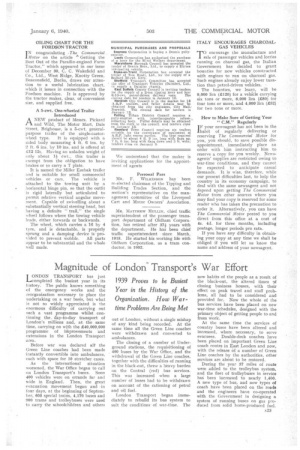Magnitude of London Transport's War Effort
Page 25

If you've noticed an error in this article please click here to report it so we can fix it.
LONDON TRANSPORT has just completed the busiest year in its history. The public knows something of the emergency works and the reorganization necessary to place the undertaking on a war basis, but what is not so widely appreciated is the enormous difficulty of carrying out such a vast programme Whilst continuing the day-to-day transport of London's millions and, at the same time, carrying on with the 240,000,000 programme of iniprovements and extensions in the London Transport area.
Before war was declared all' the Green Line coaches had been made instantly convertible into ambulances, each with space for 10 stretcher cases.
As the international situation worsened, the War Office began to call on London Transport's buses. Soon 400 vehicles were on errands far and wide in England. Then, the great evacuation movement began and 'in four days, at the beginning of September, 605 special trains, 4,170 buses and 900 trams and trolleybuses were used to carry the schoolchildren and others out of London, without a single mishap of any kind being recorded. At the same time all the Green Line coaches were withdrawn and converted to ambulances.
The closing of a number of Underground stations, the requisitioning of 400 buses by the War Office, and the withdrawal of the Green Line coaches, together with the difficulties of running in the black-out, threw a heavy burden on the Central (red) bus services. This was increased when a large number of buses had to be withdrawn on account of the rationing of petrol and oil fuel.
London Transport began immediately to rebuild its bus system to suit the conditionsof war-time. The new habits of the people as a result of the black-out, the altered times of closing business houses, with their effect on peak travel and staff problems, all had to be considered and provided for. Now the whole of the bus services have been placed on new war-time schedules, designed with the primary object of getting people to and from work.
At the same time the services of country buses have been altered and increased, where necessary, to serve evacuees. Double-deck coaches have been placed on important Green Line coach routes in East London and now, with the release of a number of Green Line coaches by the authorities, other services are about to be restored.
During the year 37 miles of route were added to the trolleybus system, and the fleet of trolleybuses in service hag been increased to nearly 1,400. A new type of bus, and new types of coach have been placed on the roads and the engineers have co-operated with the Government in designing a system of running buses on gas produced from solid home-produced fuel.




























































